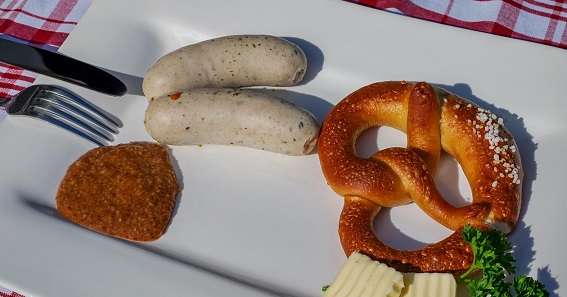
Of all the sausages in Germany’s diverse culinary landscape, Weisswurst may be the most iconic to Bavaria. With its pale white color, delicate seasoning, and ritualized morning consumption, Weisswurst is more than just a food – it’s a cultural experience.
Traditionally enjoyed before noon with sweet mustard, soft pretzels, and a wheat beer, Weisswurst embodies the slower, ceremonial rhythm of Bavarian life. This article offers an authentic Weisswurst recipe, explains its regional origins, and shares how to serve it the traditional way.
The Origins of Weisswurst Recipe
Weisswurst was first created in Munich in 1857, supposedly by accident when a young butcher ran out of sheep casings and used thicker pork ones instead. The result was a sausage that had to be cooked gently rather than grilled – and it quickly became a regional favorite.
Today, Weisswurst is considered a breakfast or brunch sausage, famous for its rule: never eat it after midday. This tradition goes back to the time before refrigeration, when sausages were made fresh and had to be consumed quickly.
Ingredients for Traditional Weisswurst
This recipe yields about 10 sausages (100–110g each).
Ingredients:
- 700 g veal shoulder (or veal and pork mixture)
- 300 g pork back fat or pork belly
- 1 small onion, finely chopped
- 1 tsp salt
- 1/2 tsp white pepper
- 1/4 tsp mace
- 1/4 tsp ground ginger
- 1/4 tsp lemon zest
- 1/4 cup fresh parsley, finely chopped
- Crushed ice or ice water (about 1/2 cup, for emulsifying)
- Pork casings, soaked and rinsed
Notes:
- Veal is traditional, but some recipes use a 60/40 veal-to-pork ratio.
- Fresh parsley and lemon zest are essential for that light, herbal flavor.
Tools and Equipment
- Meat grinder with fine plate
- Food processor or bowl chopper
- Sausage stuffer
- Pot for poaching (not boiling)
- Thermometer
- Slotted spoon
Step-by-Step Instructions
Step 1: Prepare the Meat
Cut veal and pork fat into small cubes and partially freeze for easier grinding. Grind twice – first coarsely, then finely.
Step 2: Make the Emulsion
Transfer ground meat to a food processor or bowl chopper. Add salt, pepper, ginger, mace, and lemon zest. Slowly incorporate crushed ice or ice water while blending until the mixture becomes pale, sticky, and smooth.
Add chopped parsley last and pulse briefly to incorporate.
Step 3: Stuff the Sausages
Load casings onto your sausage stuffer. Carefully fill with the Weisswurst mixture, avoiding air pockets. Twist into sausages about 12–15 cm (5–6 inches) long.
Prick small air bubbles if needed and chill the sausages in the refrigerator for at least an hour.
Step 4: Poach the Weisswurst
Bring a pot of water to a gentle simmer (not boiling) – around 75–80°C (165–175°F).
Add the sausages and poach for 20–25 minutes. They should remain white and plump, never browned.
Remove with a slotted spoon and serve immediately.
How to Serve Weisswurst (the Bavarian Way)
Weisswurst is traditionally served in its hot poaching water in a ceramic bowl at the table. It’s never grilled or fried.
Accompaniments:
- Süßer Senf (sweet Bavarian mustard)
- Brezn (soft Bavarian pretzels)
- Weißbier (Bavarian wheat beer)
Eating Etiquette:
- Traditionally, Weisswurst is peeled before eating.
- The classic method is “zuzeln” – sucking the meat out of the casing. However, many modern diners simply cut and peel the sausage.
- It’s customary to eat it before noon, especially in Bavaria.
For more German breakfast traditions, see Traditional German Breakfast.
Variations and Tips
- Some recipes include cream or egg whites to lighten the texture.
- If you don’t have veal, use a mix of pork shoulder and chicken as a substitute.
- Weisswurst can be made in advance and gently reheated in hot water.
Avoid browning or boiling Weisswurst – it will change the flavor and texture completely.
How to Store Weisswurst
- Fresh, uncooked Weisswurst should be eaten the day it’s made or the next day at most.
- Cooked Weisswurst can be stored in the fridge for up to 3 days, but will lose its delicate texture.
- Weisswurst is not typically frozen, as this affects the emulsion.
Fun Facts About Weisswurst
- Weisswurst is protected by Bavarian tradition, and many Munich locals still insist on the “noon rule”.
- The sausages are never grilled – doing so is considered culinary heresy in Bavaria.
- In beer gardens, Weisswurst is often served in a tall white ceramic pot to keep it warm.
- It’s a staple at Oktoberfest breakfasts, often paired with pretzels and Weißbier.
- The word “Weisswurstfrühstück” refers specifically to this morning meal tradition.
Weisswurst is more than just another German sausage – it’s a reflection of Bavarian identity and ritual. With its delicate veal flavor, soft texture, and ceremonial service, it’s best enjoyed slowly, ideally on a sunny morning with a warm pretzel and cold wheat beer.
By learning how to make Weisswurst from scratch, you’re not only mastering a classic recipe – you’re stepping into a centuries-old tradition that continues to shape Bavarian food culture today.
Ready for something bolder? Try our Bratwurst Recipe or explore Currywurst – Berlin’s Favorite Street Food for a spicier contrast.
Related Articles:
12 Types of German Wurst You Should Know
From Bratwurst to Blutwurst, this guide introduces 12 of Germany’s most iconic sausages. Learn what makes each one unique – and how to cook or serve them.
What Is Landjäger? Germany’s Hiking Sausage Explained
Find out why Landjäger is Germany’s go-to snack for hikers. Learn how it’s made, how to store it, and what makes it perfect for outdoor adventures.
What Is Mettwurst? Raw-Cured German Sausage Guide
Dive into the world of Mettwurst – a cured, often smoked raw sausage. Discover its regional styles, how to enjoy it safely, and what makes it different from Mett.
What Is Knackwurst? Germany’s Snappy Sausage Explained
Learn all about Knackwurst – the garlicky, juicy sausage that snaps when you bite. See how it’s made and served across Germany.
What Is Bockwurst? Mild German Sausage Explained
Bockwurst is Germany’s mild, family-friendly sausage. Find out why it’s beloved by all ages and how to poach and serve it the right way.
What Is Blutwurst? Traditional German Blood Sausage
Blutwurst is Germany’s traditional blood sausage – rich, hearty, and historic. Learn how it’s made, regional styles, and how to cook or enjoy it cold.
Nürnberger Rostbratwurst – Recipe and History
Explore the legacy of Nürnberger Rostbratwurst – the small sausage with big flavor. Includes authentic preparation methods and cultural background.
What Is Leberwurst? Types and Traditional Recipes
Leberwurst, Germany’s beloved liver sausage, comes in many forms. Discover regional variations, how it’s made, and delicious serving suggestions.
The Best Homemade Currywurst Recipe
Make authentic Berlin-style Currywurst at home with this easy recipe. Includes sausage prep, homemade curry ketchup, and street food-style serving tips.
Frankfurter Würstchen – The Original German Hot Dog
Discover the authentic Frankfurter Würstchen – Germany’s original hot dog. Learn its history, protected status, and how to heat and serve it the traditional way.
Teewurst – Soft German Sausage for Spreading
Explore Teewurst, the smoky, spreadable sausage originally served at tea time. Find out how it’s made, stored, and delicious ways to enjoy it at home.







